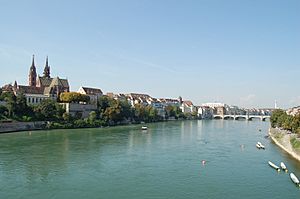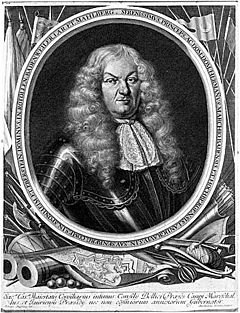Battle of Mulhouse (1674) facts for kids
Quick facts for kids Battle of Mulhouse |
|||||||
|---|---|---|---|---|---|---|---|
| Part of Franco-Dutch War | |||||||
 The Rhine, south of Mulhouse |
|||||||
|
|||||||
| Belligerents | |||||||
| Commanders and leaders | |||||||
| Strength | |||||||
| 3,000 | 5,000 | ||||||
| Casualties and losses | |||||||
| 60 | 300 killed or wounded 900-1000 captured |
||||||
The Battle of Mulhouse happened on December 29, 1674. It was fought in Alsace, a region in France. This battle was part of a larger conflict called the Franco-Dutch War. It was also part of a special plan known as Turenne's Winter Campaign.
The battle was between the French army and the Imperial army. The French were led by a famous general named Turenne. The Imperial forces were commanded by Hermann of Baden-Baden.
Before this battle, there was another fight called the Battle of Entzheim. After that battle, the Imperial army settled down for winter near Colmar. But Turenne did something unexpected. He divided his army and marched through the Vosges Mountains. He then brought his army back together near Belfort.
The Imperial army was surprised by Turenne's move. Their commander, Bournonville, sent Hermann to defend Mulhouse. But Turenne attacked and defeated Hermann's forces on December 29. A few days later, the French won another battle at Turckheim. These victories forced the Imperial army to leave Alsace.
Why the Battle Happened
The Franco-Dutch War started because King Louis XIV of France wanted to expand his country's power. In 1672, France invaded the Dutch Republic. At first, France seemed to be winning easily.
However, other countries became worried about France's growing strength. The Holy Roman Empire, Brandenburg-Prussia, and Spain joined the war against France. This made the war much bigger.
The French army in Germany was led by Turenne. Many people thought he was the best general of his time. For two years, Turenne won many battles. He often defeated larger Imperial armies.
By 1674, France was fighting on many fronts. The war became more about defending French borders. In January 1674, Denmark–Norway joined the alliance against France. England also made peace with the Dutch Republic.
In June 1674, a large Imperial army entered Alsace. They crossed the Rhine river at Strasbourg. This army had over 40,000 soldiers. Their plan was to join with more troops and then invade eastern France.
Turenne was outnumbered, but he attacked the Imperial army on October 4. This was the Battle of Entzheim. The battle didn't have a clear winner, but the Imperial forces pulled back. They went into winter camps around Colmar.
Normally, armies would stop fighting in winter. But Turenne decided to keep going. He marched his army south. He used the Vosges mountains to hide his movements. On December 27, he reached Belfort, surprising the Imperial commanders.
The Battle of Mulhouse
Turenne's arrival at Belfort surprised the Imperial commander, Bournonville. However, Turenne had to wait to gather supplies. This caused a small delay in his attack on Alsace.
Turenne learned that the Imperial forces were spread out. They were in Colmar and Altkirch. He decided to attack through Mulhouse. Mulhouse was a free city connected to Switzerland.
Turenne moved quickly with 3,000 cavalry soldiers. This was his advance group. He left his infantry (foot soldiers) to follow as fast as they could.
Bournonville hoped to defend a line along the Ill River. He wanted to gather his army there. The delay in Turenne's advance allowed Hermann of Baden-Baden to act. Hermann took about 5,000 Imperial cavalry soldiers to Mulhouse.
Turenne reached the Ill River near Mulhouse on December 29. He found seven Imperial squadrons (groups of cavalry) along the river bank. The river was shallow enough to cross at this spot.
Turenne ordered his commander, Montauban, to attack. The fight quickly grew bigger. Both sides sent more soldiers into the battle.
While this was happening, Turenne sent a large force to his right side. They advanced with a lot of noise and fanfare. This made it seem like the entire French army was arriving.
The Imperial cavalry, called cuirassiers, started to fall back into Mulhouse. Soon, the entire Imperial force retreated in a messy way. Some soldiers escaped towards Basel to find safety in Switzerland.
Turenne's army lost about 60 men. Montauban, one of his commanders, was captured. Sources disagree on how many Imperial soldiers were lost. Some say over 1,300, including prisoners. But a lower number of 300 seems more likely for this smaller battle.
What Happened Next
After the battle, Turenne went back to his main army at Belfort. His army was finally ready to continue its advance on Colmar in early January.
On January 5, Turenne defeated Bournonville again. This happened at the Battle of Turckheim. This final defeat forced the Imperial army to leave Alsace completely.
Sources
- A Relation or Journal of the Campaigns of the Marechal de Turenne, in the Years One Thousand Six Hundred Seventy Four, and One Thousand Six Hundred Seventy Five; 'Til the Time of His Death. Done from the French, By an Officer of the Army. Dublin: Addison's Head, 1732.


